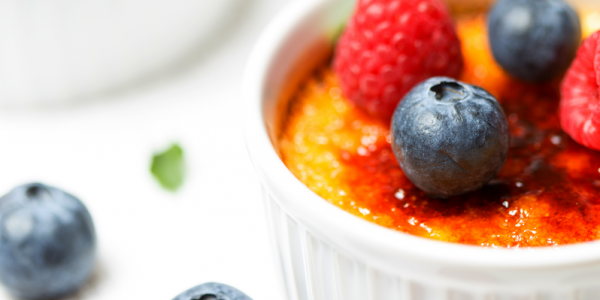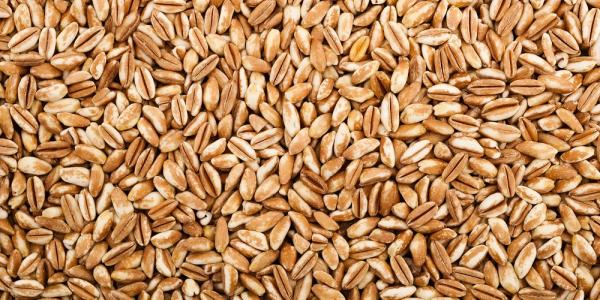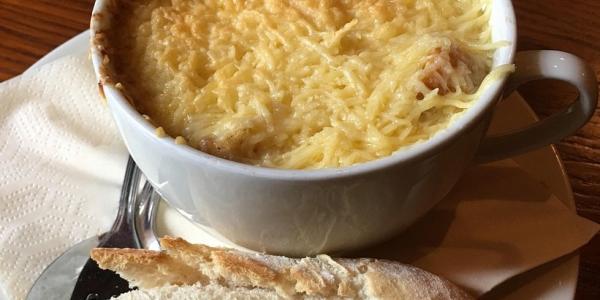Yogurt Brûlée

Ingredients
- To make your own yogurt:
- ½ gal. whole milk
- 6 T. plain yogurt
- To make Brûlée:
- 2 c. Greek-style yogurt
- ½ t. vanilla extract
- ¼ - ½ c. granulated sugar
- 2 T. raw sugar
- Fresh berries, optional
Preparation
To make your own yogurt:
Begin by sterilizing equipment with boiling water. Sanitize your work surface. Fill a large bowl or sink with ice water.
Place milk in large pot and heat over medium heat stirring occasionally to prevent skin from forming on the milk’s surface. When milk reaches 185°F to 195°F, remove from heat and place pot in ice bath, stirring occasionally until the temperature drops to 110°F to 115°F. Remove pot from ice bath. Place plain yogurt in a small bowl; stir in about a cup of the warm milk. Add to the pot of warm milk and stir gently until thoroughly mixed.
Pour mixture into yogurt maker container or insulated bottle (warmed with hot tap water). An alternative method is to wrap the covered pot in clean towels and place on heating pad on warm setting. Incubate at 110°F to 115°F for 5 to 10 hours. Do not disturb during incubation period.
To make Greek-style yogurt, line a colander with cheesecloth or a large coffee filter. Transfer yogurt into the colander and set over a medium bowl in the refrigerator for an hour or more. Whey will drain into the bowl leaving Greek-style yogurt in the colander.
To make Brûlée:
Place Greek-style yogurt, vanilla, and granulated sugar in bowl. Stir gently until combined. Taste then add more vanilla and sugar to taste.
Place 3 to 4 oz. yogurt in each ramekin. Top with raw sugar. Use torch to caramelize the top or place under broiler. Serve as is, or with your favorite fresh berries.
Learn More About Yogurt
The first yogurt most likely came about by accident. So the story goes, a few hours after milking the cows, a herdsman peered into the carrying container to find thick curds instead of fresh milk. Remarkably, yogurt-making is that simple. Simple yet complex—there’s some pretty spectacular chemistry going on.
Fresh milk naturally contains lactic acid bacteria, so named because of their unique ability to digest lactose (milk sugar). When left in a warm environment, these specialized bacteria convert lactose into lactic acid. As the milk becomes acidic, the transformation begins. Milk’s two proteins separate—the curd proteins, also called caseins, clump together to form a semi-solid mass; the whey proteins remain mixed up in the liquid. Meanwhile, the acidic environment suppresses the growth of other bacteria and keeps the milk from spoiling. And there you have it—pleasantly tart yogurt.
In much of the western world, yogurt is served sweet. Traditionally, though, unsweetened (plain) yogurt is the norm, used in savory applications. Yogurt is so versatile:
- Substitute for some or all of the mayonnaise in recipes with a creamy dressing.
- Stir it into bean dip, spinach dip, and soups as the creamy ingredient. In cooking, temper to prevent curdling.
- Use yogurt instead of milk in baking. Make sure the recipe includes baking soda to balance the acidity of the yogurt.
- Adjust the consistency of yogurt to be similar to the ingredient you are substituting. Thin yogurt with water to use in place of milk. Use Greek-style yogurt (strained regular yogurt) to substitute for sour cream or mayonnaise.
by Peggy Crum, MA, RD
Featured Recipes

Rhubarb & Strawberry Crisp
Combine tart rhubarb with sweet strawberries, add a streusel topping, and bake until bubbly. Dessert doesn’t get easier—or more classic—than this. Serve warm with a scoop of vanilla ice cream. You’re sure to get rave reviews!

Farro Salad with Grilled Vegetables
Chewy farro grains are delicious in this autumn-y salad. Recipe yields enough for dinner for 2 to 4 with some left for a couple of lunches. To do this, make the base with dressing, farro, and grilled veggies. Add fresh veggies to the base as you go.

Pecan and Dark Chocolate Chip Cookies
Roasting amps up the flavor in everything including pecans. Chef Kurt's attention to detail takes a traditional chocolate chip cookie to another level of yum!

Onion Soup
Onions, the simplest of pantry staples, mingle with butter, broth, and herbs to become luxuriously smooth and delicious. Add "homemade" croutons and a blend of cheeses to make a complete and satisfying meal.





